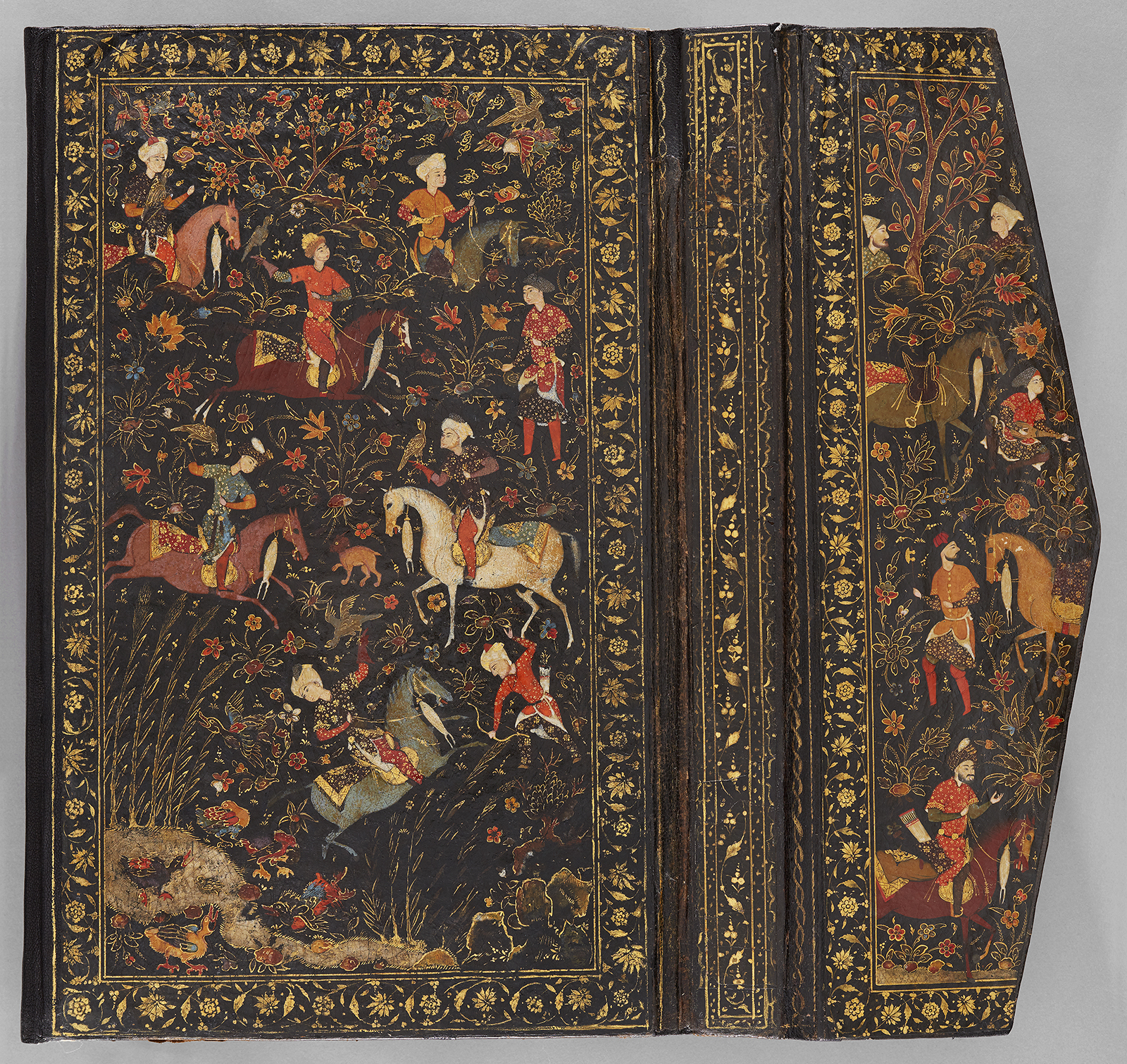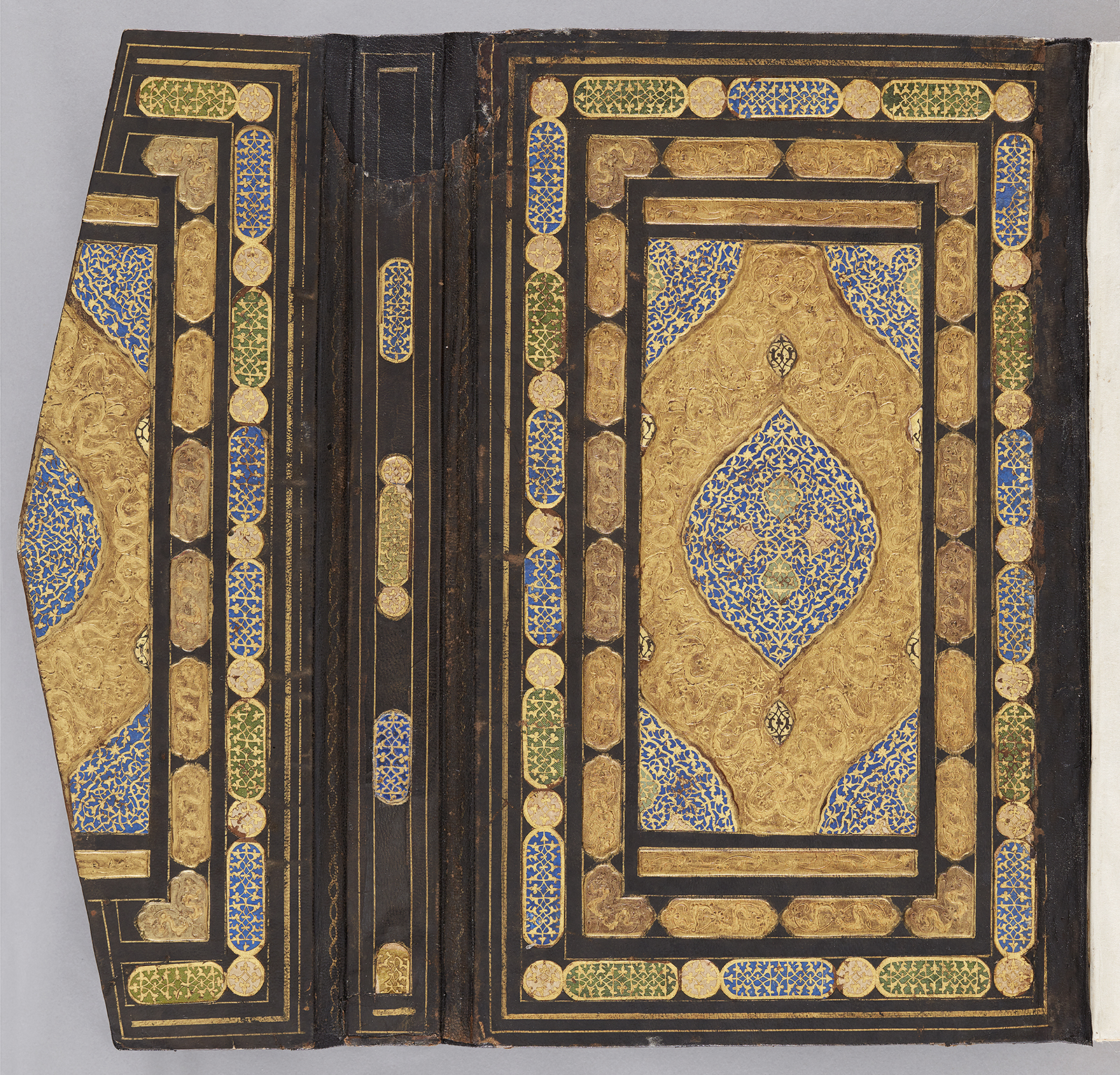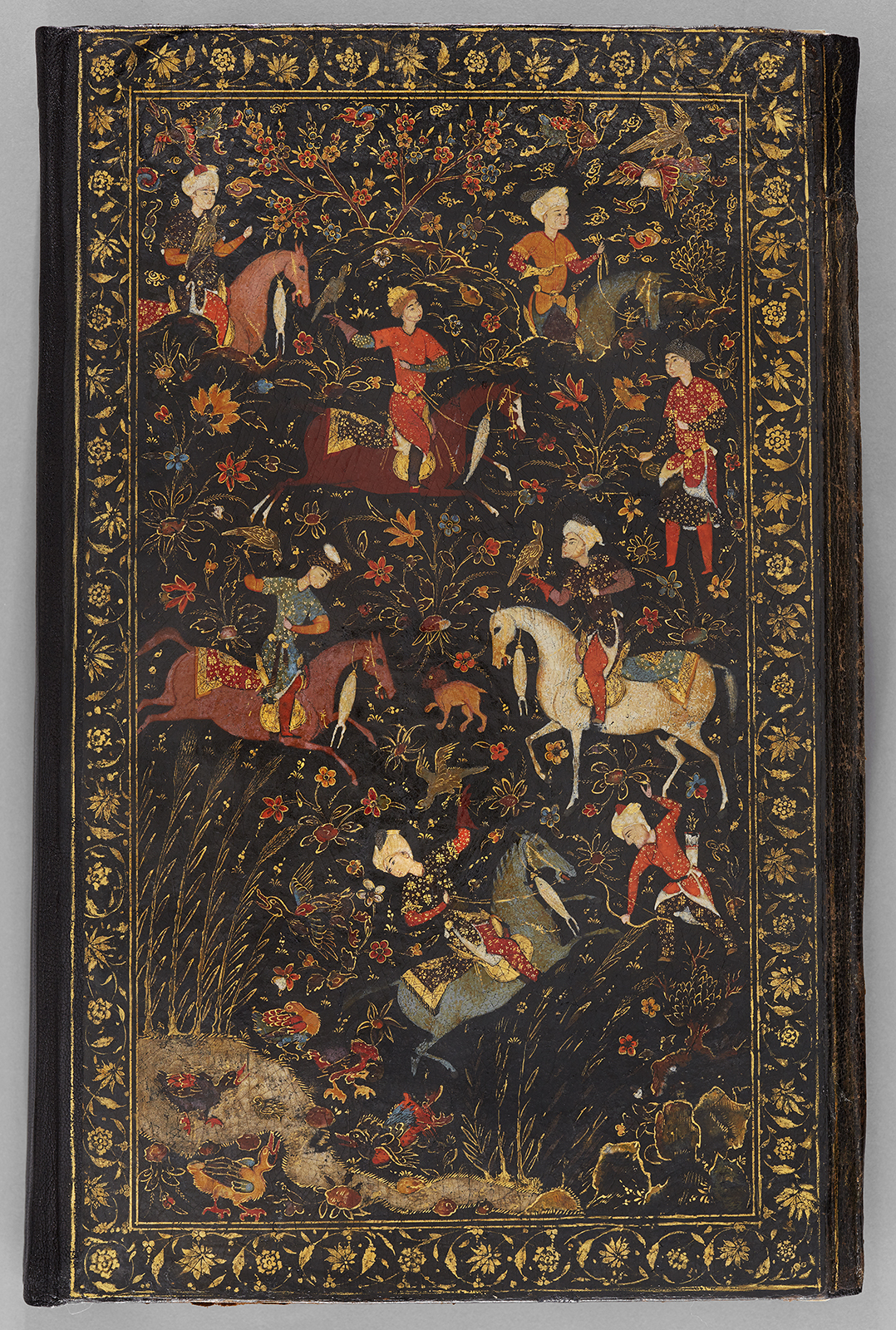Click on the image to zoom
Manuscript of the Nigaristan
- Accession Number:AKM272
- Creator:Author: Ahmad b. Muhammad Ghaffari, Persian, died 1567 Scribe: Ahmad al-Shirazi
- Place:Iran, Shiraz (probably)
- Dimensions:38.7 cm × 25 cm × 6.4 cm
- Date:1573-74 CE/980 AH/AH 980
- Materials and Technique:Ink, opaque watercolour, and gold on paper
Completed in 1552, the Kitab-i Nigaristan is a collection of historical anecdotes and incidents, written in prose and focusing largely on peculiarities in Iranian history. The manuscript’s 350 tales are narrated in chronological order, beginning with the Prophet and Imam Ali, continuing to the Abbasid caliphs and other rulers of Iran, and concluding with the Turkmen rulers.
The author is historian, scholar, and renowned chronicler of the 16th century,[1] Ahmad Muhammad Ghaffari (1504–67/68), who was from Rayy and lived in Kashan. He carried the honorific title "Qadhi" like his father and five generations before him. He dedicated the Kitab-i Nigaristan—as well as his later tome, Nosakh-i Jahanara[2] (1563–64)—to the second Safavid ruler, Shah Tahmasp (1514–76). During his lifetime, Ghaffari served several Safavid princes and was a close friend to Shah Ṭahmasp’s brother, Sam Mirza (1517–66).
This manuscript of the Kitab-i Nigaristan in the Aga Khan Museum’s Collection is dated 1573 on its colophon. Its text has been copied by the scribe Ahmad Shirazi, and it includes 44 illustrations. All of the Illustrations fill a whole folio, and most of them have text boxes on the upper and lower sides of the folio. Its folios have 16 lines of nastaliq in black with highlighted words in blue or gold, within ruled frames of orange, light green, gold, red, and blue.
The manuscript is set in the "Shiraz style," as can be seen in the depictions of elongated, slender figures and multi-faceted architecture. Shiraz long served as a centre for manuscript production, and the Turkman governor who ruled Shiraz for the greater part of the 16th century had a profound effect on its signature decorative style. As it developed, the Shiraz style also incorporated elements of the Safavid metropolitan style, which featured sumptuous details and often costly materials. The use of gold and precious minerals reached its zenith by the 1580s, and these luxury manuscripts became highly valued as gifts for the elite as well as prized additions to Ottoman book collections.
On folio 4r is a seal of the Ottoman Sultan Ahmad III (r. 1703–30), which indicates that this manuscript in the Aga Khan Museum Collection has been either commissioned by the Ottoman court or received as a diplomatic present.
Two libraries in Iran, the National Library[3] and the Malik Library,[4] hold a total of six Nigaristan manuscripts. The one in the National Library is dated 1624, and the five other manuscripts in the Malik Library date from the 16th to 19th centuries.
Furthermore, four manuscripts of the Nigaristan are held in Europe in Oxford’s Bodeleian Library[5] and in Vienna.[6] Both are dated to the 17th century. Another illustrated manuscript is in the Walters Art Museum in Baltimore. In Istanbul, three manuscripts—one dated 1610, the others not dated—are kept in the National Library. Four manuscripts of the Nigaristan are translated into Turkish[7] and are in the Nurosmaniye and Topkapı Library in Istanbul.[8]
Literature Genre of the Nigaristan
The text of the Nigaristan is in rhythmic prose, reflecting aesthetic tastes of its time. It also contains many Mongolian and Turkish terms. Each chapter begins with a section that identifies the content to follow. The titles of most chapters are translated as "A Strange Event" or "An Amazing Event." They signal to the reader that the text that follows is a nadira[9]—an Arabic phrase that means "a strange thing" and can be applied to a humourous yet instructive story.
In Persian literature, anecdotes are a widespread narrative genre. The "punch line" of an anecdote provides information about the character and way of thinking of the people involved. Most importantly, it tends to contain a moral lesson. Anecdotes have gained special significance as elements of Islamic historiography: though short and amusing, they present a warning—and an example—to present and future generations.
To view the Frontispieces, 44 paintings and Finispeices from the manuscript, see AKM272.f1v, AKM272.f2r, AKM272.f2v, AKM272.f3r, AKM272.f8v, AKM272.f16r, AKM272.f31r, AKM272.f37v, AKM272.f46v, AKM272.f52v, AKM272.f62r, AKM272.f69v, AKM272.f76v, AKM272.f84v, AKM272.f97r, AKM272.f110r, AKM272.f120r, AKM272.f124r, AKM272.f130v, AKM272.f142r, AKM272.f147r, AKM272.f150v, AKM272.f157r, AKM272.f164v, AKM272.f168v, AKM272.f181v, AKM272.f187r, AKM272.f195r, AKM272.f206v, AKM272.f217v, AKM272.f218v, AKM272.f221v, AKM272.f229v, AKM272.f234r, AKM272.f234v, AKM272.f235v, AKM272.f245r, AKM272.f252v, AKM272.f255r, AKM272.f258r, AKM272.f265v, AKM272.f276r, AKM272.f284v, AKM272.f287r, AKM272.f292r, AKM272.f309v, AKM272.f317r, AKM272.f317v, AKM272.f318r.
- Elika Palenzona-Djalili
Notes
1. See D.A. Sòafā, 608.
2. See A. Ġaffārῑ Qazwīnī, Qādòī, Tārīḫ-i Ğahān ārā, ed. Hamid Naragi. Teheran: Kitābfurūšī-i Ḥāfiẓ, 1962. The Nosakh-i Jahānārā is mentioned in many Safavid chronicles that followed. See Sholeh A. Quinn, p. 17.
3. See S. A. Anwār, Fihrist-i nusaḫ-I ḫatti -yi kitābḫāna-i Milli-yi Irān, Vol. 3. P. 344, Vol. 6. p. 411
4. See Iraj Afshar, Fihrist-i kitābhā-yi ḫatti-yi kitābḫāna-i Milli-yi Malik, Vol. 4. P. 831
5. See C.A. Storey,Vol I p. 1240.
6. See Iraj Afshar, Catalogue of Persian manuscripts, Georg Olms.
7. The title in Ottoman Turkish is: "Nüzhet-i cihān ve nādire-i devrān tercüme-i Nigāristān".
8. See www.yazmalar.gov.tr/detayli_arama.php
9. According to Ulrich Marzolph, nadira is defined as a short, witty, subtle and amusing anecdote. The Arabic root NDR refers to the field of meaning "rare." He defines it as follows: "A nadira is a story about a strange and extraordinary event, which does not necessarily have to be humorous, but due to a certain terminological constriction, it is de facto often so." See Arabia ridens: Die humoristische Kurzprosa der frühen adab-Literatur im internationalen Traditionsgeflecht, Vol. I, p. 25.
References
Afshar, Iraj. Fihrist-i kitābhā-yi ḫatti-yi kitābḫāna-i Milli-yi Malik. Tehran: Āstān Quds, Vol. 3. Tehran, 1361 š (1982), 1973-2001.
---. Catalogue of Persian manuscripts in the Austrian National Library and the Austrian State Archives in Vienna. Vienna: Austrian Academy of Sciences Press, 2003. IBSN: 9783700132066
Anwar, S. A.: Fihrist-i kitābhāy-i ḫattī-yi kitābḫāna-yi Millī-yi Īran= a catalogue of the manuscripts in the National Library of Iran. 2-17 Vol., Tehran: Kitābḫāna-yi ǧumhurī-yi Īslāmī-yi Īrān. 1990-2002. ISBN: 9789644460470
Marzolph, Ulrich. Arabia ridens: Die humoristische Kurzprosa der frühen adab-Literatur im internationalen Traditionsgeflecht. Vol. II. Frankfurt am Main: Klostermann, 1992. ISBN: 9783465025504
Quinn, Sholeh A. Historical Writing during the Reign of Shah ʿAbbas. Ideology, Imitation and Legitimacy in Safavid Chronicles. Salt Lake City: University of Utah Press, 2000. ISBN: 9780874806434
Sòafā, Ḏabīhò Allāh. Tārīḫ-i adabiyyāt-i Īrān, Vol. IV. Tehran: Čīstā, 2008.
Storey, C.A. Persian Literature. A Bibliographical Survey, 5 Vol. London: Luzac & Co., 1953. ISBN: 9780947593117
Uluç, Lale. Turkman governors, Shiraz artisans and Ottoman collectors. Sixteenth century Shiraz manuscripts, Istanbul: Türkiye İş Bankası Kültür Yayınları, 2006. ISBN: 9789754589634
Note: This online resource is reviewed and updated on an ongoing basis. We are committed to improving this information and will revise and update knowledge about this object as it becomes available.








